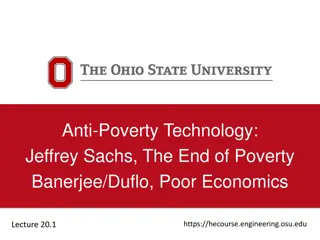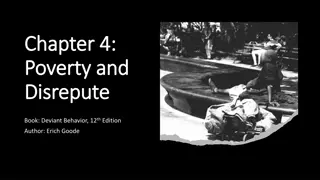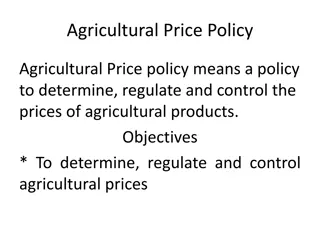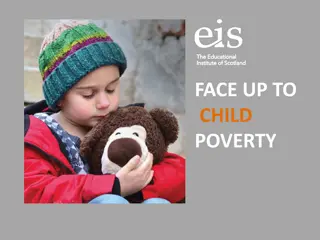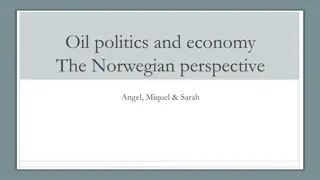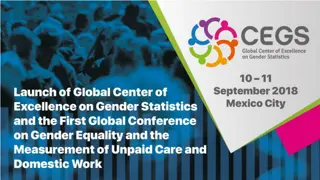Socio-Economic Impact of Oil Prices on Poverty in Azerbaijan
According to the UNDP, Azerbaijan's Human Development Index has improved but challenges persist due to the economy's reliance on natural resources, impacting poverty levels. The country faces issues with currency devaluation affecting living standards. Efforts are being made to address poverty through data collection and survey methodologies to better understand and combat the problem.
Download Presentation

Please find below an Image/Link to download the presentation.
The content on the website is provided AS IS for your information and personal use only. It may not be sold, licensed, or shared on other websites without obtaining consent from the author. Download presentation by click this link. If you encounter any issues during the download, it is possible that the publisher has removed the file from their server.
E N D
Presentation Transcript
AZRBAYCAN RESPUBLKASININ DVLT STATSTKA KOMTS Nail manov - Deputy Head of Department of Life Quality Statistics Muharram Baghirl - Advisor of Department of Life Quality Statistics
About poverty in the country According to 2014 UNDP assessment in Human Development Index Azerbaijan ranked 78th among 188 countries. Since 1995 to 2014 this estimate has increased from 0.568 to 0.751, and is in the middle of the list of highly developed countries. The crisis related to the price of oil in the world market is being reflected on the life of poor segments of population, who are firstly faced with decline in earnings.
Azerbaijan's economy is focused on the use of natural resources, and not on diversification of the economy. This factor led to the fact that the drop in oil prices led to a devaluation of the national currency, affected the strength and stability of human development. In this situation, the problem of poverty is one of the most important socio- economic problems of the Republic. To effectively solve this problem requires conditions. One of them is the selection of the poverty assessment indicators that are sufficiently reliable, comparable in time and space, as well as available for measurement. a number of
Collection, entry and processing of data of households sample survey Method of households sampling is developed in 2000 based on the recommendations of the World Bank experts. Since 2014, the State Statistics Committee of Azerbaijan has approved the program of reforming of household surveys. In order to provide representativity (0.5%), the government decided to raise the number of interviewers from 125 to 255. The sample size is determined based on the principle of optimal combination of cost and accuracy of results. The scope of work of each interviewer is 40 households in one quarter on a regular basis. Visiting of the families and data collection is being started in accordance with the instructions, schedule and weekly division, provided by the State Statistics Committee. At the end of the annual cycle all interviewers offered a present number of households not wishing for any reason or no opportunity to participate in the survey. The result is a natural rotation of 7-10 percent.
Sampling survey is conducted in all economic regions of the country by a selective method and based on the principles of voluntary participation of households. Coverage: All households living in the Republic of Azerbaijan, with the exception of the collective. survey covers 10.2 thousand households (in which 40,200 Sample size: members of the household) on a quarterly basis. Taking into account the requirements, the optimal size of the sample-more than 0, 5% -was calculated and adopted. Compilation of the sample: Used territorial random sampling, based on the 1999 census data on the level of economic regions of the Azerbaijan Republic, urban and rural population. Representativeness: The sample provides a representative survey on the results of economic regions and the whole country. Interviewer s burden: the burden per interviewer in urban and rural areas is 40 households.
DATA PROCESSING on clusters requires careful organization. The data processing is divided into 2 stages: primary and secondary data processing PRIMARY DATA PROCESSING - obtaining reliable data files. Primary data processing involves the following steps: - The introduction of questionnaires on the cluster in a data file; - Verification of the data file structure; - The re-introduction of data and the subsequent verification of the data file; - Create a backup trusted and reconciled data file; - The second level of editing the data file; - make a copy of the edited or final data file. SECONDARY DATA PROCESSING - is provision with analytical data files and the preparation of standard tables. Secondary data processing involves the following steps: - Integration of all data files in the cluster by one data file; - Export of data in SPSS system; - Calculation of sample weights; - Calculation of the index of well-being; - Recoding variables to simplify analysis; - Creation of tables required for data analysis; - Archiving and dissemination of data files
The results of the survey are being developed in the whole Republic, by economic regions. The outcomes are microdata containing anonymized information for each household during the period of examination and aggregated data, developed in accordance with the official statistical methodology. In developing the budget survey the results of the statistical weights are applied, allowing to distribute the results of the survey on the general population. The main aggregates developed on the basis of the survey include: disposable resources of households; cash income of households; consumption expenditure of expenditure of households. The findings allow to develop consumption indicators for grouping a large number of features that characterize the households and their members in various aspects. Publication of the results of sample survey of household budgets is carried out by State Statistics Committee on a regular basis. households; final consumption
Integration TQS into Household Budget Survey SESRIC organized a study visit on 'Integration of Tobacco Questions for Surveys (TQS): Module 1- Survey Design and Methodology' on 13-15 April 2015 in Baku with the participation of seven officials from Household Budget Survey and LSMS Department of the State Statistical Committee (SSC) of the Republic of Azerbaijan under the frame of the project initiated by SESRIC on the Integration of TQS into ongoing national surveys in Organization of Islamic Cooperation (OIC) Member States. The study visit was facilitated by Mr. Mehmet G nal, Expert from Health Statistics Department of Turk Stat. The study visit focused on the following items: -Global Adult Tobacco Survey Applications General Information (2008, 2012) -Global Adult Tobacco Survey Applications 2012 Questionnaire -Turkey Health Survey Applications General Information (2008, 2010, 2012, 2014) -Turkey Health Survey Questionnaire 2008, 2010, 2012, 2014 Tobacco Module -Comparison: Global Adult Tobacco Survey, Turkey Health Survey (2008, 2010, 2012)
GATS Objectives Global study of adult population about smoking is the world standard of the systematic monitoring of tobacco use among adults and monitoring of key indicators of tobacco control. The study is a national representative survey that uses standart protocol in all countries of the world, including Azerbaijan. GATS increases capacity of the country in the field of development, implementation and estimation of the program on tobacco control. This survey gives opportunity to the countries to fulfill their obligations in accordance with WHO World Framework Convention on Tobacco Control (FCTC) to gather comparable data inside of the country and across countries. WHO has developed a package of selected measures on reduction of demands. -Monitorinn of tobacco consumption and prevention policies -Protection of people from tobacco smoke -Offering help in order to stop smoking -Warning on hazards related with tobacco -ban on distribution of advertising on selling and sponsorship by tobacco companies -tax increasing on tobacco products
GATS Methodology GATS uses a global standardized methodology which includes information on respondent, tobacco consumption (smoking and smokeless), stop tobacco use, passive cigarette smoke, economy, mass media, and knowledge, attitudes and aspects, related with tobacco use. GATS has been carried out in Azerbaijan in 2015, as households survey covering persons aged 15 years old and over, by assistance of Main Computing Center in cooperation with SESRIC. Multi-stage, geographically clustered sample design was used to obtain nationally representative data. Generally 5865 households were selected and one person from each household was randomly selected. Interviews N household N people Total 255 23 1 5865 Survey information is collected electronically using portable devices. Total 5783 interviews were conducted. The overall level of responses made 98.6%
Total (ALL) Total (ALL) Sample Cond. survey 5865 5783 SEX Male Female 2762 2719 3103 3064 Adult 1 Member 963 950 2 Member 1123 1106 3 Member 959 946 4 Member 1181 1162 5 Member 950 941 6+ Member 689 678 Urb_Rur Urban 3105 3071 Rural 2760 2712 EDUCAT Doctor of Philosophy Master s degree 16 15 696 689 Bachelors College 343 339 743 726 Technical School 374 370 Secondary 3033 2993 Basic 573 566 Primary 84 82 No education 3 3
The following table shows the distribution of adults by various demographic characteristics. Countries may choose to reporting other demographic characteristics such as religion, race / ethnicity, employment status, wealth, marital status, literacy, or the geographic region and others Total (ALL) 5783 age_grup 950 15-24 2052 25-44 2103 45-64 678 65+
Detailed Smoking Status by Gender, % Smoking Status Over-all Male Female Current tobacco smoker 17,6 35,3 1,3 Daily smoker 17,0 34,1 1,2 Occasional smoker 0,6 1,2 0,1 Occasional smoker, formerly daily 0,3 0,5 - Occasional smoker, never daily 0,4 0,7 0,1 Current non-smoker 82,4 64,7 98,7 Former smoker 2,1 4,0 0,4 Former daily smoker 0,8 1,6 0,2 Former occasional smoker 1,3 2,4 0,3 Never smoker 80,3 60,7 98,3
Current Smokers of Various Smoked Tobacco Products, by Selected Demographic Characteristics, % Type of Cigarette Demographic Characteristics Any smoked tobacco product Hand- rolled Any cigarette1 Manufac-tured Other smoked tobacco2 Overall Gender Male Female Age (years) 15-24 25-44 45-64 65+ Residence Urban Rural Education Level3 Doctor of Philosophy PhD Masters degree Bachelors degree 17,6 17,5 17,5 0,0 0,9 35,3 1,3 35,1 1,2 35,1 1,2 0,0 1,6 0,2 - 5,8 18,8 22,5 16,9 5,6 18,6 22,4 16,8 5,6 18,6 22,4 16,8 - - - 1,0 1,0 0,5 1,1 0,1 17,9 17,3 17,6 17,3 17,6 17,3 - 1,4 0,3 0,0 10,1 17,1 12,9 10,1 16,9 12,9 10,1 16,8 12,9 - - - - 1,4 1,2 College, technicum (vocational school) Technical school Secondary Basic Primary 20,3 29,4 18,5 7,9 6,5 20,1 29,1 18,4 7,4 6,5 20,1 29,1 18,4 7,4 6,5 - - - - 0,7 1,7 0,6 1,1 0,5 0,5 Note: Current use includes both daily and occasional (less than daily) use. 1Includes manufactured cigarettes, hand rolled cigarettes, and kreteks. only among respondents 15+ years old. 2Includes [describe products included in other category here]. 3Education level is reported only among respondents 15+ years old.
Cigarettes Smoked per Day Among Daily Cigarette Smokers, by Selected Demographic Characteristics, % Demographic Characteristics Number of cigarettes smoked on average per day <5 5-9 10-14 4,5 7,3 15-24 25 Overall Gender Male Female Age (years) 15-24 25-44 45-64 65+ Residence Urban Rural Education Level2 Doctor of Philosophy PhD Masters degree Bachelors degree 22,2 59,2 6,8 4,5 3,4 7,1 14,3 21,8 30,6 60,1 35,9 6,5 15,8 - 2,0 8,5 7,3 6,4 32,4 28,4 17,2 19,5 65,7 53,4 62,1 61,4 - 4,4 5,2 3,8 5,3 8,1 8,9 5,1 3,8 9,9 4,3 25,7 17,9 52,2 67,6 7,1 6,4 - - 44,9 15,8 26,5 - 55,1 6,7 15,6 6,5 3,2 15,4 4,2 55,7 50,5 College, technicum (vocational school) Technical school Secondary Basic Primary 5,1 8,6 3,6 9,0 3,9 6,6 1,4 20,6 15,3 25,6 13,0 30,7 60,2 60,8 59,2 71,7 61,9 5,3 11,4 5,0 14,0 7,4 - - -
Exposure to Tobacco Smoke at Home, by Smoking status and Selected Demographic Characteristics , % Respondents exposed to tobacco smoke at home1 Overall 24,4 Demographic Characteristics Non-smokers 18,2 Overall Gender Male Female Age (years) 27,6 21,5 13,5 21,1 20,1 19,2 17,3 15,1 15-24 25-44 45-64 65+ Residence Urban Rural Education Level2 Doctor of Philosophy PhD Masters degree Bachelors degree 22,3 26,2 24,6 22,2 25,7 22,9 19,0 17,2 4,5 19,1 19,7 - 14,0 14,2 College, technicum (vocational school) Technical school Secondary Basic Primary 26,2 30,2 25,6 23,2 16,0 18,7 21,3 19,3 18,9 14,2 1 Respondents who reported that smoking inside the home occurs daily, weekly, or monthly. 2Education level is reported only among respondents 15+ years old.
Exposure to Tobacco Smoke at Indoor Work Areas, by Smoking Status and Selected Demographic Characteristics, % Respondents exposed to tobacco smoke at work1 Overall 45,1 Demographic Characteristics Non-smokers 42,1 Overall Gender Male Female Age (years) 15-24 25-44 45-64 65+ Residence Urban Rural Education Level3 Doctor of Philosophy PhD Masters degree Bachelors degree 54,3 33,0 53,2 33,0 48,1 47,8 41,9 45,9 47,6 45,0 38,1 42,2 45,8 43,5 43,1 40,1 50,7 35,8 44,0 50,7 33,6 44,4 College, technicum (vocational school) Technical school Secondary Basic Primary 40,8 46,5 50,8 59,9 6,4 36,2 46,6 47,1 56,4 8,2 1In the past 30 days. Among those respondents who work outside of the home who usually work indoors or both indoors and outdoors. \2Education level is reported only among respondents 15+ years old
Current Smokers who Made a Quit Attempt and Received Health Care Provider Assistance in the Past 12 Months, by Selected Demographic Characteristics Smoking cessation and health care seeking behavior Demographic Characteristics Advised to quit by HCP2,3 Made quit attempt1 Visited a HCP1,2 42,8 26,8 74,2 Overall Gender Male Female Age (years) 15-24 25-44 45-64 65+ Residence Urban Rural Education Level4 42,7 44,4 27,1 19,2 74,7 56,4 35,8 44,8 42,8 40,1 13,7 27,2 26,3 34,2 82,9 78,0 69,9 77,2 41,9 43,8 21,2 33,6 86,3 64,9 Doctor of Philosophy PhD Masters degree Bachelors degree College, technicum (vocational school) Technical school Secondary Basic Primary 55,1 45,3 52,0 - 83,5 85,7 87,9 23,4 34,7 48,3 43,3 40,6 31,2 81,0 24,4 19,7 28,7 26,4 61,9 82,7 65,8 92,6 81,2 - 1 Among current smokers. 2HCP = health care provider. 3Among current smokers who visited a HCP during the past 12 months. 4Education level is reported only among respondents 15+ years old.
Noticing Anti-Cigarette Smoking Information During the Last 30 Days in Newspapers or Magazines and Television, by Smoking Status and Selected Demographic Characteristics , % Gender Age (years) Residence Places Overall Male Female 15-24 Urban Rural 25 Overall In newspapers or in magazines 43,2 48,4 38,3 43,9 43,0 42,6 43,9 On television 66,3 71,7 61,4 66,9 66,2 65,3 67,5 Current smokers1 In newspapers or in magazines 49,2 49,0 52,8 56,2 48,8 47,9 50,7 On television Non-smokers2 75,6 76,3 57,0 69,3 76,0 73,7 77,9 In newspapers or in magazines 41,9 48,1 38,2 43,1 41,6 41,4 42,4 On television 64,3 69,1 61,4 66,8 63,7 63,5 65,3
Current Smokers who Noticed Health Warnings on Cigarette Packages and Considered Quitting Because of the Warnings During the Last 30 Days, by Selected Demographic Characteristics , % Current smokers1 who Noticed health warnings on cigarette package2 Thought about quitting because of warning label2 87,6 48,3 Overall Gender Male Female Age (years) 15-24 25-44 45-64 65+ Residence Urban Rural Education Level3 Doctor of Philosophy PhD Masters degree Bachelors degree College, technicum (vocational school) Technical school Secondary Basic Primary 1 Includes daily and occasional (less than daily) smokers. 2 During the last 30 days. 3Education level is reported only among respondents 15+ years old. 88,3 70,1 48,9 33,0 84,1 89,6 87,1 85,5 39,5 52,4 45,5 52,0 84,3 91,6 48,6 48,0 100,0 85,9 83,8 55,1 52,0 53,0 87,5 83,8 88,9 87,4 100,0 55,8 44,6 46,8 34,6 81,0
Noticing Cigarette Advertising During the Last 30 Days in Various Places, by Selected Demographic Characteristics, % Gender Age (years) Residence Places Overall Male Female 15-24 Urban Rural 25 Noticed advertisements in stores Noticed cigarette promotions 24,3 29,0 19,9 22,2 24,7 26,1 22,0 13,8 17,4 10,5 11,8 14,2 18,3 8,5 Free samples 1,9 3,0 0,9 2,0 1,9 2,5 1,2 Sale prices Coupons Free gifts/discounts on other products Clothing/item with brand name or logo 3,0 4,5 4,5 5,1 1,6 4,0 2,6 3,1 3,0 4,9 4,2 7,3 1,5 1,2 5,7 7,5 4,1 3,9 6,1 8,0 3,1 5,7 6,9 4,6 6,1 5,6 6,9 4,2 Mail promoting cigarettes 1,1 1,6 0,6 1,3 1,0 1,7 0,3
Average Amount Spent on a Pack of Cigarettes and Cost of 100 Packs of Cigarettes as a Percentage of Gross Domestic Product (GDP) per Capita Local Currency, AZN Average amount spent on 20 manufactured cigarettes 1,4 Overall (%) Cost of 100 packs of manufactured cigarettes as a percentage of per capita Gross Domestic Product (GDP) 2,4 The table provides two economic indicators which are calculated among current smokers who smoke manufactured cigarettes at least once per week. Both of these estimates use a weighted average cost that is equivalent to the total expenditure on manufactured cigarettes per day across the target population divided by the total daily consumption of manufactured cigarettes.
Discussion The "tobacco or tobacco products" on the law are subject to fines for smoking in prohibited places. This is reflected in the Code of Administrative Offences. According to the Code places where smoking is prohibited by law, shall be fined 30 manat. According to the Code enterprises, institutions, organizations and visible allocation of special places for smoking, the "No Smoking" sign warning letter or a failure to ensure that the officials in the amount of 400 manat (250 $), legal entities shall be fined in the amount of 1,000 manat (645 $ ). "Tobacco or tobacco products" on the basis of law, education, health, health and cultural facilities, as well as sports competitions and other events in the halls, administrative buildings and private offices, excluding special places for smoking in the workplace, high-class restaurants, cafes, bars, except for the trade, public catering, household facilities, residential buildings and other indoor places of public use, transport distance, except for specially designated areas, smoking is prohibited in all forms of public transport. Sale of tobacco and tobacco products is prohibited in the following cases: 1. In the absence of relevant certificates for each shipment of products; 2. marking with excise stamps and tobacco products; 3. nicotine, tar and carbon monoxide content of more than the upper limit; 4. tobacco box warning about the harmful effects of smoking on health are absent; 5. Making boxes of tobacco products and to maintain compliance with the requirements of the relevant regulatory documents; 6. The sale to persons under the age of 18; 7. sold through vending; 8. cigarettes, cigarettes and cigarillos sold piecemeal. In addition, other paragraphs of the law where necessary is planned: 1. If necessary, buyers sellers of tobacco products shall have the right to request a document proving their age. 2. training, educational, health, medical and cultural facilities, as well as the sale of goods in the sale of tobacco products to children and adolescents is not allowed. 3. The harmful effects of smoking in places of trade in tobacco products, ban the sale of tobacco products to persons under the age of 18, as well as other articles that serve to restrict the use of tobacco products should be. Regulated by law, the fight against tobacco







